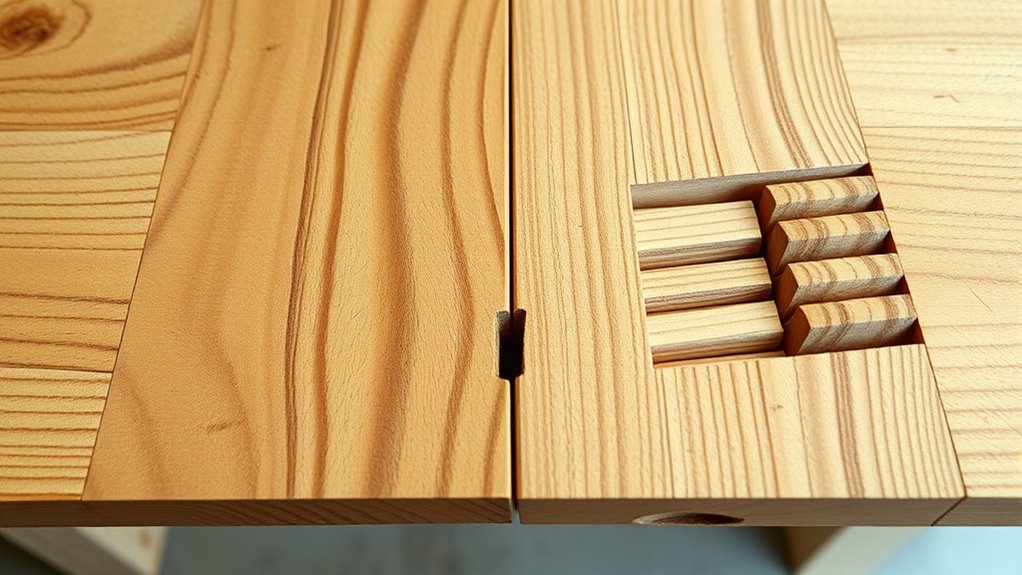Dovetail joints can be crafted by hand or with jigs, each offering unique benefits. Hand-cut joints require patience, skill, and precision, giving you a handcrafted look with slight variations that showcase craftsmanship. Jig-cut joints use templates or guides for quick, consistent, and clean results, perfect for a professional finish. Both methods produce strong, durable connections. Want to discover which method suits your project best? Keep exploring to learn more about the differences and techniques.
Key Takeaways
- Hand-cut dovetails require precision, patience, and manual carving for a unique, artisanal appearance, while jig-cut methods use guides for consistency.
- Both techniques produce strong, durable joints, but hand-cut dovetails offer slight irregularities that showcase craftsmanship.
- Jig-cut dovetails ensure quick, uniform, and clean cuts suitable for modern woodworking projects.
- The choice depends on personal preference: handcrafted aesthetic versus efficiency and precision.
- Proper technique and attention to detail are essential in both methods to ensure joint strength and visual appeal.

Have you ever wondered how skilled craftsmen create strong, seamless joints in woodworking? The answer often lies in dovetail joints, which are renowned for their durability and visual charm. Whether hand-cut or made with a jig, understanding the nuances of these methods helps you appreciate how joint strength and aesthetic appeal come together in fine woodworking. When you craft a dovetail joint, you’re not just assembling two pieces of wood—you’re creating a connection that’s both resilient and beautiful.
Dovetail joints combine strength, beauty, and craftsmanship in woodworking.
Hand-cut dovetails demand precision, patience, and a sharp eye. As you carve each tail and pin, you’re actively shaping the joint’s interlocking parts, which ensures maximum contact area. This meticulous process results in a joint with exceptional joint strength because the tight fit resists pulling apart under stress. The craftsmanship involved also enhances the aesthetic appeal; each hand-cut dovetail bears the signature of your skill, with slight variations that give your project a unique, artisanal look. This handcrafted touch often impresses viewers and adds a sense of authenticity to your work.
In contrast, using a jig simplifies the process, making dovetail joints more accessible and quicker to produce. A jig guides your saw or router along precise templates, ensuring consistent cuts and tight fits. While this method may lack the slight irregularities of hand-cut joints, it doesn’t compromise on joint strength if set up correctly. Properly made jig-cut dovetails still provide robust connections suitable for most woodworking projects. The aesthetic appeal might differ—jig-cut dovetails tend to be cleaner and more uniform, which can suit modern or minimalist styles. They’re ideal when you want a professional look without investing excessive time or effort into hand tools.
Regardless of the method, the core principle remains the same: the dovetail joint’s inherent design offers excellent resistance to pulling apart, making it one of the strongest woodworking joints. The choice between hand-cut and jig methods depends on your priorities—whether you value the personal touch and character of hand craftsmanship or the efficiency and consistency of jig-assisted cuts. Both approaches can produce joints with impressive joint strength and aesthetic appeal, but your personal skills, project requirements, and style preferences will guide your decision. Mastering either technique elevates your woodworking, allowing you to create furniture and boxes that are both sturdy and visually enthralling. Ultimately, the secret to a successful dovetail joint lies in the care you put into each cut—whether made by hand or machine. Proper technique plays a crucial role in ensuring the joint’s durability and beauty over time.
Frequently Asked Questions
Which Method Is More Durable for Heavy-Duty Furniture?
You’ll find that hand-cut dovetail joints tend to be more durable for heavy-duty furniture because they emphasize wood strength and precise fitting. This meticulous craftsmanship enhances joint longevity, making it resistant to stress over time. Jig-cut joints, while efficient, may not match the durability of hand-cut ones under heavy loads. So, if you want lasting strength and resilience, hand-cut dovetails are your best choice for demanding furniture.
Can Dovetail Joints Be Used in Outdoor Projects?
You can definitely use dovetail joints in outdoor projects, but it’s a case of “reading the weather report” first. Focus on weather resistance and material compatibility—use rot-resistant woods like cedar or teak, and seal the joints properly. These steps help prevent moisture damage and guarantee durability. While dovetails aren’t traditionally outdoor joints, with the right treatment, they can hold up well in exterior furniture.
How Long Does It Typically Take to Master Hand-Cut Dovetails?
It typically takes you several months of consistent practice to master hand-cut dovetails, depending on your learning curve and dedication. With regular skill development, you’ll notice steady improvement in precision and confidence. Expect to spend around 20-50 hours honing your technique, but remember, patience and persistence are key. As you progress, your ability to cut clean, tight dovetails will become more natural, reflecting your growing craftsmanship.
Are There Safety Concerns With Using Jigs for Dovetails?
Using jigs for dovetails is generally safe if you follow proper safety precautions. You should always wear eye protection, keep your hands away from blades, and make certain your tools are well-maintained. While jigs reduce the risk of mistakes, neglecting safety measures or poor tool maintenance can lead to accidents. Remember, staying attentive and maintaining your tools helps keep your woodworking safe and enjoyable.
What Are the Cost Differences Between Hand-Cut and Jig Methods?
The cost comparison between hand-cut and jig methods varies based on your tools and materials. Hand-cutting typically involves higher material expenses due to the need for quality chisels and saws, but it’s cheaper upfront without specialized machinery. Jigs require an initial investment in the jig itself and possibly power tools, which can be costly. Over time, jigs may save you money by increasing efficiency, while hand-cutting remains more budget-friendly for small projects.
Conclusion
Whether you choose to hand-cut dovetails or use a jig, mastering these joints adds strength and beauty to your woodworking. Did you know that traditional hand-cut dovetails can take up to twice as long as jig-cut ones? Still, many woodworkers swear by the craftsmanship and personal touch of hand-cut methods. Whichever you prefer, honing your technique will elevate your projects and showcase your skill. Happy building!









